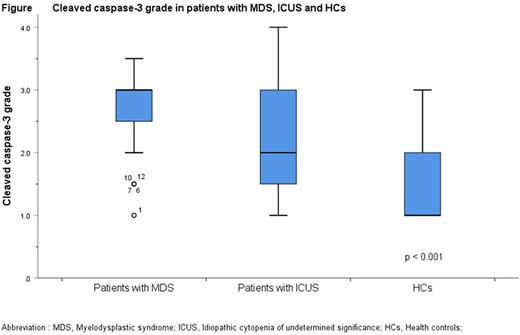Abstract
Background: Myelodysplastic syndrome (MDS) is a heterogenous, clonal disorder in hematopoiesis. Pathophysiology of MDS is not clear yet, but there is growing interest in association with cellular proliferation and apoptosis. We hypothesized that Ki-67 and cleaved caspase-3 could be prognostic markers representative of proliferation and apoptosis in MDS patients.
Methods: We performed retrospective study using bone marrow samples from 76 MDS patients who was diagnosed between 2004 and 2014 at Seoul National University Hospital. We compared Ki-67 and cleaved caspase-3 to evaluate cellular proliferative and apoptotic activities using immunohistochemical testing (IHC). And we additionally analyzed Ki-67 and cleaved caspase-3 between patients with MDS, idiopathic cytopenia of undetermined significance (ICUS) and health controls (HCs) based on data previously studied. And we also compared difference according to MDS risk scoring system.
Results: Cleaved caspase-3 was highest in MDS patients, followed by ICUS patients and HCs (2.70, 95% CI: 2.56-2.85 vs. 2.19, 95% CI: 1.85-2.54 vs. 1.45, 95% CI: 1.17-1.73, p < 0.001). Similarly, the mean Ki-67 grade was also highest in MDS patients, followed by ICUS patients and HCs (1.72, 95% CI: 1.55-1.90 vs. 1.58, 95% CI: 1.30-1.86 vs 1.05, 95% CI: 0.95-1.16, p = 0.001) (Figure). Higher cleaved caspase-3 grade was significantly associated with lower IPSS-R score (p = 0.020), whereas Ki-67 was not. Interestingly, TET2 mutation was associated with decreased cleaved caspase-3 levels (p = 0.030). In terms of survival, there is no significant difference according to cleaved caspase-3 or Ki-67. In addition, we divided patients with MDS into four groups: lower-risk MDS patients with lower caspase-3 levels (A group : n = 32), lower-risk MDS patients with higher caspase-3 levels (B group : n = 13), higher-risk MDS patients with lower caspase-3 levels (C group : n = 28), and higher-risk MDS patients with higher caspase-3 levels (D group : n= 2). We compared PFS and OS between the four groups and found that high-risk MDS patients with lower caspase-3 showed significantly worse PFS than the other groups (p < 0.001; A vs B, p = 0.655; B vs C, p = 0.018; A vs C, p < 0.001)
Conclusion: Our results suggest that apoptotic activity gradually increases from HCs, patients with ICUS to patients with MDS. Therefore, we could predict apoptotic activity from cleaved caspase-3. In addition, higher apoptotic activity was associated with better MDS patient prognostic scores and survival outcomes. Further studies are needed to reveal the the differences in apoptotic activity between lower- and higher-risk MDS.
Disclosures
Yoon:Yuhan Pharmaceutical: Research Funding; Kyowa Kirin: Research Funding; Tikaros: Consultancy; Astellas Pharma: Consultancy; Celgene: Consultancy; Janssen Pharmaceutical: Consultancy; Takeda: Consultancy; Chugai Pharmaceutical: Consultancy; Novartis: Consultancy; Amgen: Consultancy; Roche-Genetech: Research Funding.
Author notes
Asterisk with author names denotes non-ASH members.


